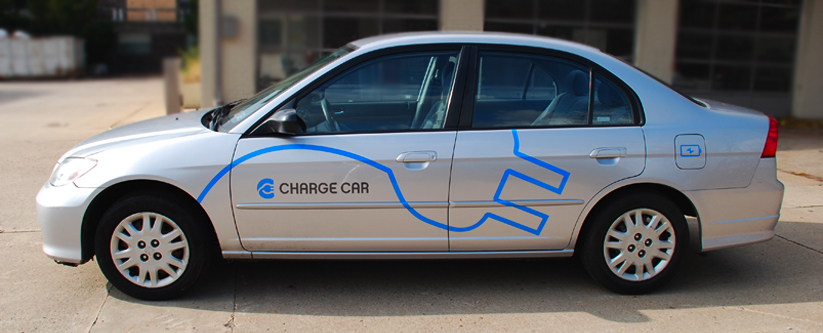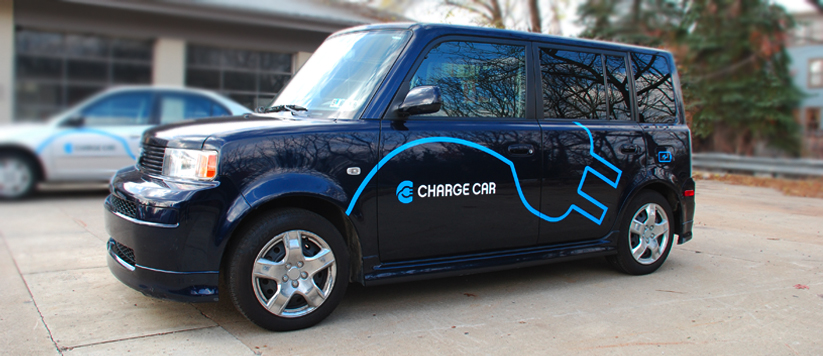3 Prong plug-in connection
100% Electric ChargeCars
 Civic Photo Gallery
Civic Photo Gallery
Honda Civic 7th Generation (2001-2005)
| Vehicle Mass: | 2700lb / 1230kg |
| Battery Pack: | 33 x 100 Ahr Lithium-Iron-Phosphate Cells 10.56kWh at 106V nominal |
| Charge Time: | 10 hours for full charge at 120VAC, 12A |
| Range: | 40+ miles |
| Motor Power: | 40HP (30kW) peak |
| Top Speed: | >75 mph |
The 2005 Honda Civic LX shown here was converted to operate purely on electric power as a short-range commuter vehicle. The vehicle was stripped of its internal combustion engine and associated components: radiator and cooling system, fuel tank, exhaust system, extraneous wiring, etc. A HPGC AC-31 motor (with Curtis 1238-7501 controller) was connected to the existing 5-speed manual transmission with a custom-machined adapter plate and shaft coupler. The battery pack comprises 33 Thundersky TS-100 (100Ah, 3.2V, 106V total) lithium iron phosphate batteries mounted in the trunk, along with a 120VAC 12A charger and battery management system. The 12V battery and electrical system were kept intact to power lights, blowers and other accessories, supplemented/charged by a 106V-12V DC converter deriving power from the battery pack. An electro-hydraulic pump can be manually activated to provide power-steering assist. An electric vacuum pump provides brake assist. A 1kW electric heater provides cabin heating through the existing heater core. Net weight gain from the conversion is approximately 100 pounds.
Performance of the vehicle has been very satisfactory. The car accelerates well (~2 seconds to 20mph) and cruises at highway speed, utilizing the 5-speed transmission. We have driven at over 70mph on a level highway, and have gone over 40 miles on a single charge in typical mixed, highway and urban driving. This range is adequate for daily commutes that are typically less than 20 miles, even considering unexpected diversions. Charging a fully depleted battery pack requires about 10 hours (apx. 5 miles range per hour of charging) with the on-board charger that operates on any 120VAC 15A outlet. Much faster charging could be achieved with a higher power charger on a high current, 230V circuit.
Construction and testing of this vehicle confirmed the suitability of the components and system as a whole. The subsystems have been refined and repackaged for reliability and ease of conversion, and installed in a 2002 Honda Civic EX, along with a custom driver interface display unit. The trunk-mounted battery pack fits neatly in the spare-tire well, leaving most of the original trunk space available. This second Civic will serve as our model for the conversion process. We are currently getting bids from outside companies to fabricate and assemble the subsystems. Once we have licensed the technology to an outside company, the "recipe" will be handed to local garages (such as Baum Blvd. Automotive with whom we are working) who will be trained to commercially perform conversions on this and/or similar vehicles.
While the conversion kit has been designed specifically for the 7th generation Honda Civics, recent findings indicated that it should work as well in the 6th generation Civics (1996-2000). The trunk space for battery placement is equivalent to the 7th generation, and the engine compartment is slightly larger. The car is also several hundred pounds lighter, which would improve acceleration and range.
 Scion Photo Gallery
Scion Photo Gallery
Scion xB 2006
| Vehicle Mass: | 2615lb / 1186kg |
| Battery Pack: | 4 x 12v Deep Cycle Marine Lead Acid Cells |
A combination energy storage system composed of moderate-rate secondary batteries and supercapacitors leverages the best qualities of each energy storage technology. By shifting the high current duty for acceleration and regenerative braking from the battery to a supercapacitor, a number of factors are significantly changed:
- Battery degradation due to high current discharge and charge is substantially reduced.
- Battery degradation due to total-Amps-handled is substantially reduced.
- High-current resistive losses of energy in the battery are reduced.
- Battery degradation due to heating is reduced.
This allows use of batteries that are less expensive, and a battery pack that should last longer, lowering total-cost-of-ownership. This approach should also allow more of the battery's available energy to be utilized, allowing a smaller battery pack for the same range. And a smaller battery pack translates into a lighter vehicle, also increasing range.
To run experiments to investigate these hypotheses we have developed a testbed vehicle based on a 2006 Scion xB with 3 kWh of deep-cycle lead-acid batteries and a 52 Wh supercapacitor. This is a 48v system that drives four 9hp brushed DC motors. Two motors are coupled to each half-axle through a 4:1 reduction gearbelt drive. The single speed allows plenty of low-end torque for starting and a top speed of 40 mph.
Optimal management of this compound energy system requires intelligent algorithms to predict energy demands for the road just ahead and adjust the energy stored in the supercapacitor. Variables that significantly impact the energy demands of a commuter vehicle include: stop and go traffic conditions; unique individual human driving habits; and elevation changes throughout the commute. We are continuing to research an optimal control system for a combination supercapacitor-battery energy storage system.

